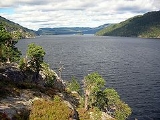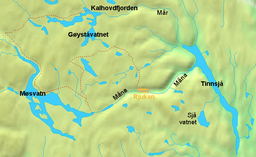
Tinnsjå
Encyclopedia
Tinnsjå is one of the largest lakes in Norway. It is located between the municipalities of Tinn
and Notodden
in Telemark
county. At its source in the west, the Måna
river flows out of Møsvatn
and past Rjukan
into Tinnsjå. From the north, the river Mår flows from the Mår, Gøystavatn, and Kalhovdfjorden
lakes to join the Måna river before entering Tinnsjå. Tinnsjå is part of the Skiensvassdrag, and drains via the Tinnelva
river in the south, down to Heddalsvatn.
In 1944, during the German occupation of Norway, the ferry SF Hydro
was sunk in Tinnsjå by the Norwegian resistance
. The Germans were using the ferry to transport a large quantity of heavy water
to Germany, where it was to be used for nuclear weapon research. The heavy water had been produced at Vemork
, a factory located in Rjukan
. The wreck of the ferry was discovered in 1993. In 2004, it was investigated and filmed for an episode of NOVA
; heavy water samples were recovered and deuterium
isotopic enrichment
was confirmed.
In April 2005, a previously unknown species of fish was discovered in Tinnsjå. A film crew shooting footage for a new documentary on the heavy water sabotage became aware of an unusual fish, swimming near the lake bottom at a depth of 430 m. The light-colored, translucent fish was about 15 cm long and seemed to lack a swimming bladder.

Tinn
Tinn is a municipality in Telemark county, Norway. It is part of the traditional region of Øst-Telemark. The administrative centre of the municipality is the town of Rjukan....
and Notodden
Notodden
is a town and municipality in Telemark county, Norway. It is part of the traditional region of Øst-Telemark. The administrative centre of the municipality is the town of Notodden....
in Telemark
Telemark
is a county in Norway, bordering Vestfold, Buskerud, Hordaland, Rogaland and Aust-Agder. The county administration is in Skien. Until 1919 the county was known as Bratsberg amt.-Location:...
county. At its source in the west, the Måna
Måna
Måna or Måne is a river in Tinn, Norway; it flows from Møsvatn through Vestfjorddalen and Rjukan to Vestfjorden in Tinnsjå. It is part of the Skiensvassdraget drainage basin....
river flows out of Møsvatn
Møsvatn
Møsvatn is twelfth largest lake in Norway with a surface area of 78.31 km². It lies primarily in Vinje municipality in Telemark county. The lake lies in the watershed of the Skien river and discharges into the Måna river. Along the shores of the lake, many traces of stone age settlers can be...
and past Rjukan
Rjukan
Rjukan is a town and the administrative center of Tinn municipality in Telemark . It is situated in Vestfjorddalen, between Møsvatn and Tinnsjå, and got its name after Rjukanfossen west of the town. The Tinn municipality council granted township status for Rjukan in 1996. The town has 3 386...
into Tinnsjå. From the north, the river Mår flows from the Mår, Gøystavatn, and Kalhovdfjorden
Kalhovdfjorden
Kalhovdfjorden is a lake belonging to the municipality Tinn in the province of Telemark in southern Norway.Kalhovdfjorden belongs to the catchment of the river Skien. The river Mår comes out of the lake. The lake is part of the Skiensvassdraget...
lakes to join the Måna river before entering Tinnsjå. Tinnsjå is part of the Skiensvassdrag, and drains via the Tinnelva
Tinnelva
Tinnelva is a river in Notodden, Telemark, Norway. It flows from the lake Tinnsjå to Heddalsvatnet. The waterfalls Årlifossene, Grønvollfoss, Svelgfoss and Tinnfoss are exploited, and the hydroelectric power stations have a combined installed capacity of ....
river in the south, down to Heddalsvatn.
In 1944, during the German occupation of Norway, the ferry SF Hydro
SF Hydro
SF Hydro was a Norwegian steam powered railway ferry that operated on Tinnsjø in Telemark. The ferry operated between Mæl and Tinnoset between 1914 and 1944, connecting the two railways Rjukanbanen and Tinnosbanen. The railway was used to transport raw materials and fertilizer from Norsk Hydro's...
was sunk in Tinnsjå by the Norwegian resistance
Norwegian heavy water sabotage
The Norwegian heavy water sabotage was a series of actions undertaken by Norwegian saboteurs during World War II to prevent the German nuclear energy project from acquiring heavy water , which could be used to produce nuclear weapons...
. The Germans were using the ferry to transport a large quantity of heavy water
Heavy water
Heavy water is water highly enriched in the hydrogen isotope deuterium; e.g., heavy water used in CANDU reactors is 99.75% enriched by hydrogen atom-fraction...
to Germany, where it was to be used for nuclear weapon research. The heavy water had been produced at Vemork
Vemork
Vemork is the name of a hydroelectric power plant outside Rjukan in Tinn, Norway. The plant was built by Norsk Hydro and opened in 1911, its main purpose being to fix nitrogen for the production of fertilizer. Vemork was later the site of the first plant in the world to mass-produce heavy water...
, a factory located in Rjukan
Rjukan
Rjukan is a town and the administrative center of Tinn municipality in Telemark . It is situated in Vestfjorddalen, between Møsvatn and Tinnsjå, and got its name after Rjukanfossen west of the town. The Tinn municipality council granted township status for Rjukan in 1996. The town has 3 386...
. The wreck of the ferry was discovered in 1993. In 2004, it was investigated and filmed for an episode of NOVA
NOVA (TV series)
Nova is a popular science television series from the U.S. produced by WGBH Boston. It can be seen on the Public Broadcasting Service in the United States, and in more than 100 other countries...
; heavy water samples were recovered and deuterium
Deuterium
Deuterium, also called heavy hydrogen, is one of two stable isotopes of hydrogen. It has a natural abundance in Earth's oceans of about one atom in of hydrogen . Deuterium accounts for approximately 0.0156% of all naturally occurring hydrogen in Earth's oceans, while the most common isotope ...
isotopic enrichment
Isotope separation
Isotope separation is the process of concentrating specific isotopes of a chemical element by removing other isotopes, for example separating natural uranium into enriched uranium and depleted uranium. This is a crucial process in the manufacture of uranium fuel for nuclear power stations, and is...
was confirmed.
In April 2005, a previously unknown species of fish was discovered in Tinnsjå. A film crew shooting footage for a new documentary on the heavy water sabotage became aware of an unusual fish, swimming near the lake bottom at a depth of 430 m. The light-colored, translucent fish was about 15 cm long and seemed to lack a swimming bladder.


